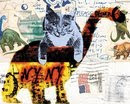OCDC’s Get The Blessing is a good humored and refreshing urban party! The fat, club era bass meshes surprisingly well with sax. The parameters of free playing are outlined just as a wah–wah re-orients our preconceptions. Hand claps help create a folky spirit that further sketches out OCDC'S sonic blueprint.
The distinctive color of a baritone sax blends perfectly with
trumpet enabling each voice to interact while remaining clarified within their
own registers. The result of this unique mix is a new rock conscious sophisticated
urban jazz.
The opening of Americano Meccano reminds me of the famous opening feed – back
guitar from I Feel Fine. The natural
sound of birds is cleverly orchestrated setting off the baritone – and
resulting in a jazz pop orchestration that isn’t fusion – or even hybrid – but
an organic coming together of corollary styles. Peaches n Regalia from Frank
Zappa’s Hot Rat’s album comes to mind.
Torque opens with some old school delay – like a Tel-Ray panning
across the stereo field. Once again the orchestral sense of the band
shines as the Jam Band bass emphasis creates a nice color contrast with the
trumpet. The piece builds into a surreal piano cadenza as the trippy rhythmic delay dissipates.
Adagio in Wot Minor begins with some sustained horns, setting up a striking
and beautiful moment as the rhythm section enters featuring a 1960's sounding tremolo guitar framing the classic
horn lines and defining the OCDC
sound. The track vacillates between the two sensibilities: mid- 60’s Blue Note
horn melodies and an early progressive rock soundscape – a little bit Soft- Machine – a little bit Zappa. The beautiful delay / reverb
guitar drops of aural paint on the canvas of the horn solos and the mysterious
– secret agent era guitar… could only
be OCDC. The Adagio maintains it’s identity while cohesively revealing it’s
musical DNA lineage both in the processed elements and how they
interact with the improvisational elements.
Between Fear and Sex opens with a bass and drum / percussion section
followed by a sax head. The bass and drum groove is killin’ on this one !
Horns soulfully lay out the melody and mood shifting into an
almost klezmery spirit as the piece
grooves along till the drums enter through the soaring spirited melodic line. The
horns kind of echo each other – entrance wise – as some spacey bass and percussion
carry out Fear and Sex.
A funky bass groove will pull you into
The Waiting. Mellow high-hats and Andrew Hill era horn lines sail over the rock grooves. Get The Blessing treats each piece as a composition –never lapsing into
perfunctory traditional solo head solo forms. OCDC has a keen sense for
this kind of orchestral balance – and an excellent compositional awareness that
often opens up a spotlight to a hip sound , a distinctive wah-wah and bass sonority or
a classic two horn arrangement.
This music is made for a live gig --and these structures are
malleable enough so that an infinite amount of variations are conceivable in
the context of live shows.
A classic plucked bass groove – ends the piece. As with
several other tunes on the recording the narrative often opens or spills into a
solo section –giving the production of the record a cinematic dimension. Get
The Blessing is a spirited and textural generational get -together!
Two horns open Low Earth Orbit with a muscular beat Lovely tom-toms leading
into a sax solo are augmented by some smart trumpet guide lines and finely
tuned pedal rich guitar strokes. Swells, flanges and filter sweeps fill out the
Low Earth Orbit stratosphere.
Petopia begins with bass and a harpy sounding guitar. The texture
here is lovely and strong! The drums – dropping in and out every few bars spotlights
the guitar tremolo ethos and effectively sets the party vibe structures in
place. More Hot Rats era Zappa feel through
these mercurial textures. The hand–clapping – and almost Klezmer like sax over a 60”s funky sounding
clav guitar and muted trumpet takes Petopia
out as the long sustained reverb of the horn drifts away.





